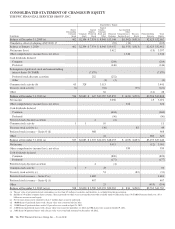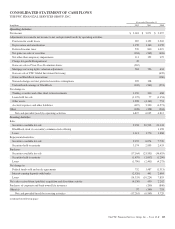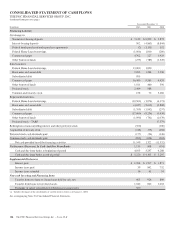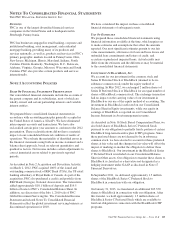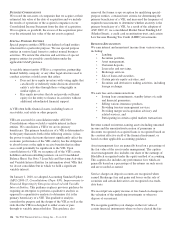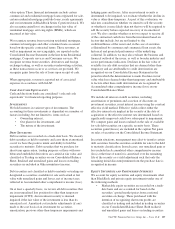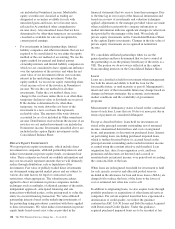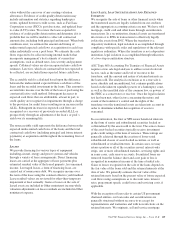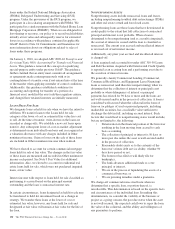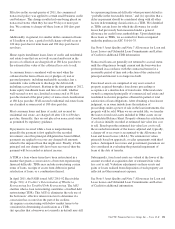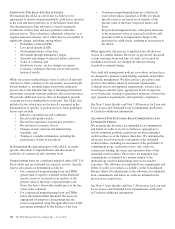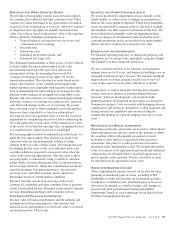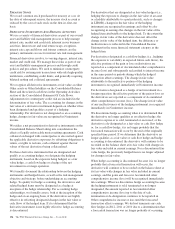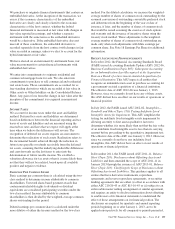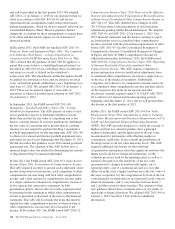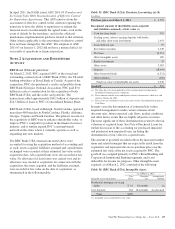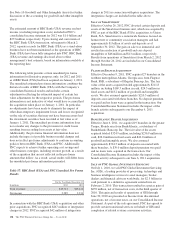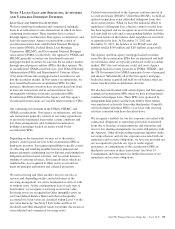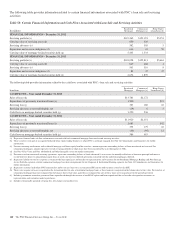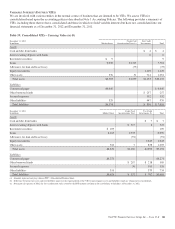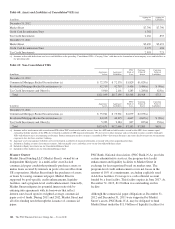PNC Bank 2012 Annual Report Download - page 151
Download and view the complete annual report
Please find page 151 of the 2012 PNC Bank annual report below. You can navigate through the pages in the report by either clicking on the pages listed below, or by using the keyword search tool below to find specific information within the annual report.A
LLOWANCE
F
OR
L
OAN
A
ND
L
EASE
L
OSSES
We maintain the ALLL at a level that we believe to be
appropriate to absorb estimated probable credit losses incurred
in the loan and lease portfolios as of the balance sheet date.
Our determination of the allowance is based on periodic
evaluations of these loan and lease portfolios and other
relevant factors. This evaluation is inherently subjective as it
requires material estimates, all of which may be susceptible to
significant change, including, among others:
• Probability of default (PD),
• Loss given default (LGD),
• Outstanding balance of the loan,
• Movement through delinquency stages,
• Amounts and timing of expected future cash flows,
• Value of collateral, and
• Qualitative factors, such as changes in current
economic conditions, that may not be reflected in
historical results.
While our reserve methodologies strive to reflect all relevant
risk factors, there continues to be uncertainty associated with,
but not limited to, potential imprecision in the estimation
process due to the inherent time lag of obtaining information
and normal variations between estimates and actual outcomes.
We provide additional reserves that are designed to provide
coverage for losses attributable to such risks. The ALLL also
includes factors which may not be directly measured in the
determination of specific or pooled reserves. Such qualitative
factors may include:
• Industry concentrations and conditions,
• Recent credit quality trends,
• Recent loss experience in particular portfolios,
• Recent macro-economic factors,
• Changes in risk selection and underwriting
standards, and
• Timing of available information, including the
performance of first lien positions.
In determining the appropriateness of the ALLL, we make
specific allocations to impaired loans and allocations to
portfolios of commercial and consumer loans.
Nonperforming loans are considered impaired under ASC 310,
Receivables and are evaluated for a specific reserve. Specific
reserve allocations are determined as follows:
• For commercial nonperforming loans and TDRs
greater than or equal to a defined dollar threshold,
specific reserves are based on an analysis of the
present value of the loan’s expected future cash
flows, the loan’s observable market price or the fair
value of the collateral.
• For commercial nonperforming loans and TDRs
below the defined dollar threshold, the loans are
aggregated for purposes of measuring specific
reserve impairment using the applicable loan’s LGD
percentage multiplied by the balance of the loan.
• Consumer nonperforming loans are collectively
reserved for unless classified as TDRs, for which
specific reserves are based on an analysis of the
present value of the loan’s expected future cash
flows.
• For purchased impaired loans, subsequent decreases
to the net present value of expected cash flows will
generally result in an impairment charge to the
provision for credit losses, resulting in an increase to
the ALLL.
When applicable, this process is applied across all the loan
classes in a similar manner. However, as previously discussed,
certain consumer loans and lines of credit, not secured by
residential real estate, are charged off instead of being
classified as nonperforming.
Our credit risk management policies, procedures and practices
are designed to promote sound lending standards and prudent
credit risk management. We have policies, procedures and
practices that address financial statement requirements,
collateral review and appraisal requirements, advance rates
based upon collateral types, appropriate levels of exposure,
cross-border risk, lending to specialized industries or borrower
type, guarantor requirements, and regulatory compliance.
See Note 5 Asset Quality and Note 7 Allowances for Loan and
Lease Losses and Unfunded Loan Commitments and Letters
of Credit for additional information.
A
LLOWANCE
F
OR
U
NFUNDED
L
OAN
C
OMMITMENTS
A
ND
L
ETTERS
O
F
C
REDIT
We maintain the allowance for unfunded loan commitments
and letters of credit at a level we believe is appropriate to
absorb estimated probable credit losses on these unfunded
credit facilities as of the balance sheet date. We determine the
allowance based on periodic evaluations of the unfunded
credit facilities, including an assessment of the probability of
commitment usage, credit risk factors, and, solely for
commercial lending, the terms and expiration dates of the
unfunded credit facilities. The reserve for unfunded loan
commitments is estimated in a manner similar to the
methodology used for determining reserves for funded
exposures. The allowance for unfunded loan commitments and
letters of credit is recorded as a liability on the Consolidated
Balance Sheet. Net adjustments to the allowance for unfunded
loan commitments and letters of credit are included in the
provision for credit losses.
See Note 5 Asset Quality and Note 7 Allowances for Loan and
Lease Losses and Unfunded Loan Commitments and Letters
of Credit for additional information.
132 The PNC Financial Services Group, Inc. – Form 10-K


